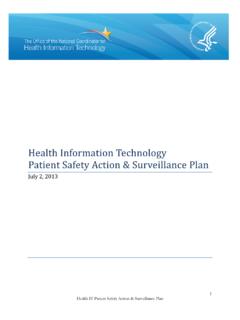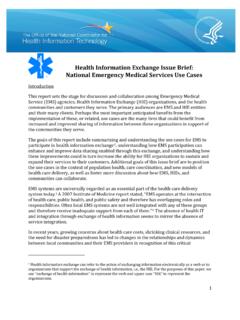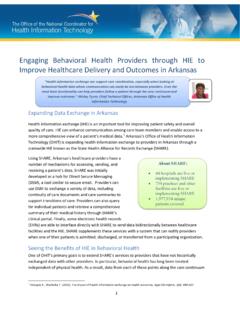Transcription of Change Management in EHR Implementation
1 June 2016 Version Change Management in EHR Implementation Primer June 2016 Version ii The following resource can be used in support of the EHR Implementation Lifecycle. It is recommended by boots-on-the-ground professionals for use by others who have made the commitment to implement or upgrade to certified electronic health record (EHR) systems. EHR Implementation Lifecycle Description and Instructions This primer is intended to aid providers and health information technology (health IT) implementers with Change Management for EHR Implementation . Change Management is the basic foundation underlying all phases of the EHR Implementation Lifecycle and helps achieve EHR Meaningful Use and practice transformation.
2 The EHR Implementation Lifecycle shows the phases a practice goes through in a successful Implementation . Change Management strategies and principles must be integrated into all phases of the Implementation process. This Change Management primer synthesizes the strategies and principles proposed by John Kotter, one of the leading experts in planning organizational Change using a structured Change Management approach. This resource includes the following sections: Section 1 introduces the basic Change Management principles and explains why managing any Change effectively is important to the success of EHR Implementation and other practice transformation initiatives.
3 Section 2 provides more detail on implementing Kotter s principles in practice settings that are focused on managing specific organizational changes commonly seen in practices today. The discussion focuses on ways to help practice leaders optimize the use of health IT to move their practice to a desired Future State. Section 3 provides a summary of critical success factors and the Management interventions that must occur to achieve success with Change initiatives and some must do steps to effectively manage Change . Section 4 provides additional resources related to Change Management . June 2016 Version iii TABLE OF CONTENTS 1 What Is Change Management and Why Is It Important? .. 1 Introduction.
4 1 Phase 1: Creating a Climate for Change .. 2 Phase 2: Engaging and Enabling the Organization .. 3 Phase 3: Implementing and Sustaining the Changes .. 3 How Will Change Impact People, Processes, and Technology? .. 4 Changing How People Work .. 4 Changing Processes .. 5 Changing the Technology .. 5 2 What Steps Do I Need to Take to Get Started? .. 6 Paper to EHR .. 6 Action Steps for Phase 1: Creating a Climate for Change .. 6 Action Steps for Phase 2: Engaging and Enabling the Organization .. 7 Action Steps for Phase 3: Implementing and Sustaining the Changes .. 7 Achieving to Meaningful Use Patient Engagement .. 9 Action Steps for Phase 1: Creating a Climate for Change .. 9 Action Steps for Phase 2: Engaging and Enabling the Organization.
5 9 Action Steps for Phase 3: Implementing and Sustaining the Changes .. 10 Replacing an Existing EHR .. 12 Action Steps for Phase 1: Creating a Climate for Change .. 12 Action Steps for Phase 2: Engaging and Enabling the Organization .. 12 Action Steps for Phase 2: Implementing and Sustaining the Changes .. 12 New Models of Care: Patient-Centered Medical Home (PCMH) and Alternative Payment Models (APMs) .. 15 Action Steps for Phase 1: Creating a Climate for Change .. 15 Action Steps for Phase 2: Engaging and Enabling the Organization .. 16 Action Steps for Phase 3: Implementing and Sustaining the Changes .. 16 3 Measuring the Effectiveness of Your Change Management Strategies to Enhance Success.
6 18 4 Resources .. 21 June 2016 Version iv LIST OF EXHIBITS Exhibit 1: Kotter's Three-Phased Approach to Managing Change .. 1 Exhibit 2: Overview of the Three Phases of Kotter s Change Management Principles and Related Actions for Paper to 8 Exhibit 3: Overview of the Three Phases of Kotter s Change Management Model and Related Actions for Meaningful Use Achievement .. 11 Exhibit 4: Overview of the Three Phases of Kotter s Change Management Model and Related Actions for Upgrade/Rip and Replace .. 14 Exhibit 5: Care Coordination and Health IT .. 15 Exhibit 6: Overview of the Three Phases of Kotter s Change Management Model and Related Actions for Alternative Payment Models (APMs) .. 17 Exhibit 7: Managing Change Through Active Practice Leader Intervention.
7 18 Exhibit 8: Critical Success Factors and Management Interventions for Managing Change .. 19 June 2016 Version 1 1 What Is Change Management and Why Is It Important? Introduction Change Management is the application of the set of tools, processes, skills, and principles for managing the people side of Change to achieve the required outcomes of a Change project or initiative. The Change Management Learning Center Change in health care is moving at a rapid pace as practices strive to implement regulatory and policy requirements, such as ICD10; understand new models of care such as patient-centered medical homes (PCMHs); and continue their own quality improvement efforts.
8 Many practices are doing all of this while implementing a certified electronic health record technology (CEHRT) to achieve Meaningful Use. This Change is happening at a time when providers are still seeing patients and trying to maintain a healthy work life balance. These are clearly stressful times for providers and their staff, and adapting to Change has become a way of life for their practices. Fortunately, Change Management is a well-developed field with significant evidence and leading practices on how to successfully navigate the Change process. One of the leading thinkers in planning organizational Change and providing practical strategies for navigating Change is John Kotter.
9 Kotter believes that any Change has both emotional and situational components, and he has proposed a multistep Change model. The model is organized into three phases to help leaders manage the challenges that are inherent in any Change initiative (Campbell, 2008). Exhibit 1 illustrates how Kotter s three-phased approach can be used when planning a Change from the current way of doing business and caring for patients to the vision you have for your future practice, one that optimizes the use of technology to provide safe, high-quality, and efficient patient care services while meeting regulatory requirements. Exhibit 1: Kotter's Three-Phased Approach to Managing Change June 2016 Version 2 As illustrated , Kotter s Change Management Model points to the need to think of the Change process as a journey for the entire organization.
10 The journey will be smoother if everyone understands: Why they need to leave the Current State. Why the Future State is better for their patients and the practice. What changes in workflows will be necessary. What technologies and new skills will be required. How staff will learn those new skills and gain knowledge of how the technology fits into their everyday work life. The following section is a brief overview of the three phases of Kotter s Change Management Model and the Management focus required during each phase. Phase 1: Creating a Climate for Change In this phase, practice leaders must create a climate for Change by accomplishing the following: Establishing a sense of urgency: o What could be improved from our Current State?

















